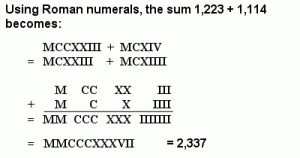ROMAN MATHEMATICS – Numerals & Arithmetic
 |
Roman numerals |
By the middle of the 1st Century BCE, the Roman had tightened their grip on the old Greek and Hellenistic empires, and the mathematical revolution of the Greeks ground to halt. Despite all their advances in other respects, no mathematical innovations occurred under the Roman Empire and Republic, and there were no mathematicians of note. The Romans had no use for pure mathematics, only for its practical applications, and the Christian regime that followed it (after Christianity became the official religion of the Roman empire) even less so.
 |
Roman arithmetic |
Roman numerals are well known today, and were the dominant number system for trade and administration in most of Europe for the best part of a millennium. It was decimal (base 10) system but not directly positional, and did not include a zero, so that, for arithmetic and mathematical purposes, it was a clumsy and inefficient system. It was based on letters of the Roman alphabet – I, V, X, L, C, D and M – combines to signify the sum of their values (e.g. VII = V + I + I = 7).
Later, a subtractive notation was also adopted, where VIIII, for example, was replaced by IX (10 – 1 = 9), which simplified the writing of numbers a little, but made calculation even more difficult, requiring conversion of the subtractive notation at the beginning of a sum and then its re-application at the end (see image at right). Due to the difficulty of written arithmetic using Roman numeral notation, calculations were usually performed with an abacus, based on earlier Babylonian and Greek abaci.
<< Back to Diophantus | Forward to Mayan Mathematics >> |
